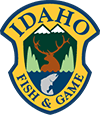Chukar
HABITAT
Steep, grassy terrain with rock outcroppings.
TASTE
Tender white meat has a similar taste to chicken. Excellent table fare.
ABUNDANCE
Moderate to excellent populations.
LICENSE, TAGS AND PERMITS NEEDED
Valid Idaho hunting license.
SPECIES INFORMATION
The chukar is a game bird native to Asia, and was first introduced into Nez Perce County, Idaho in 1933. Subsequent releases of game-farm birds into unoccupied habitat established chukars throughout most suitable habitat in Idaho by 1957.
Chukars are capable of surviving in habitat degraded by invasive annual grasses and wildfire, and threats to their habitat are not as significant compared to other upland game birds. However, chukars used habitats degraded by exotic plants less than habitats comprised of native shrubs and perennial grasses. In North America, the Great Basin is similar to chukar habitat in India, Pakistan, Afghanistan, and China. Chukars typically utilize areas of steep topography with cliff formations, rocky outcrops, talus slopes, and canyon bottoms with riparian vegetation. Cover is usually provided by rocky outcrops, talus slopes, and vegetation. Roosting sites are closely associated with rock outcrops and the periphery of talus slopes. Habitat selection varies by season, with shrub cover types selected more often in summer.
Chukars forage on the ground, often scratching to uncover seeds, shoots, and bulbs. Food items vary across their range in North America, but chukars commonly eat seeds and green leaves of cheatgrass, redstem filaree and fiddleneck seeds, and root nodules of prairie star. Insects are also important, especially to young birds. Some research suggests chukars also ingest a concerning amount of lead shot, which has been shown to lead to chukar mortality.
Water is a fundamental requirement for chukars, and dependence on free water varies by time of year, amount of precipitation, and moisture levels in food items. Distribution of chukars during summer and early autumn is largely determined by availability of water, and large groups may gather at water sources. Chukars will utilize rivers and streams, springs, seeps, and water developments to obtain water, but require adjacent shrub cover for protection from predators. Some chukar populations are not associated with free water as they make use of succulent plant parts, such as wild onion bulbs, which result in 30% greater moisture content in their diets. Although artificial water sources were previously installed to benefit chukar and other species in Idaho, this practice has largely been discontinued because of the relatively greater amount of precipitation in Idaho, as compared to bordering states (i.e., NV and UT) where widespread guzzler installation is common and beneficial to chukar. Water dependence is likely site specific, and high dietary moisture of chukar food items may reduce necessity of artificial free-water sources.
Cold winters with deep snow pack can be a critical period for chukars. During winter, south facing slopes and ridges that stay relatively snow free are important. Chukars can dig through Chukars form breeding pairs between February and March, and nest initiation is determined by photoperiod, temperature, and food availability. In years of limited resources, chukars may not initiate nests and reproduce. When conditions are extremely poor, coveys may reassemble without attempting to nest. Nests are depressions in the ground lined with vegetation and feathers; and are often hidden in rocks or under shrub and grass cover. If the nest fails, females will attempt to renest. Weather impacts on food availability and cover are thought to strongly influence chukar reproductive success; however, heavy precipitation and cold weather during early brood rearing may result in increased chick mortality, as suggested for other partridge species.

